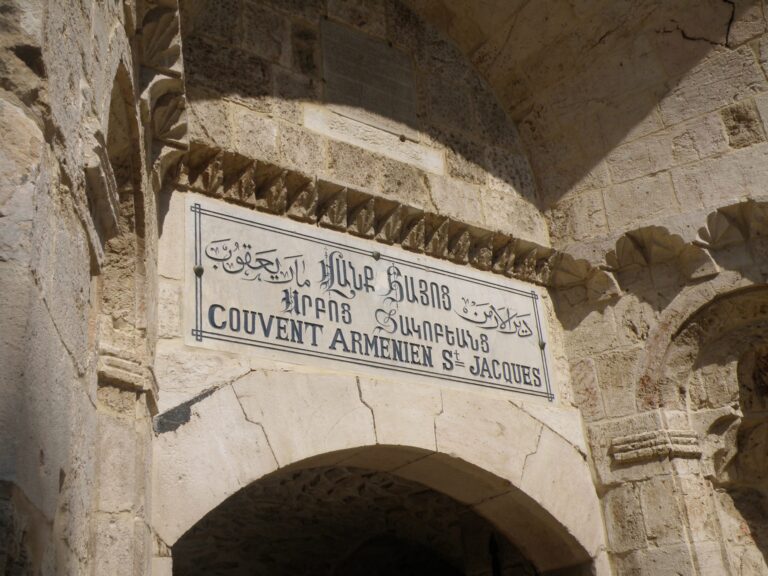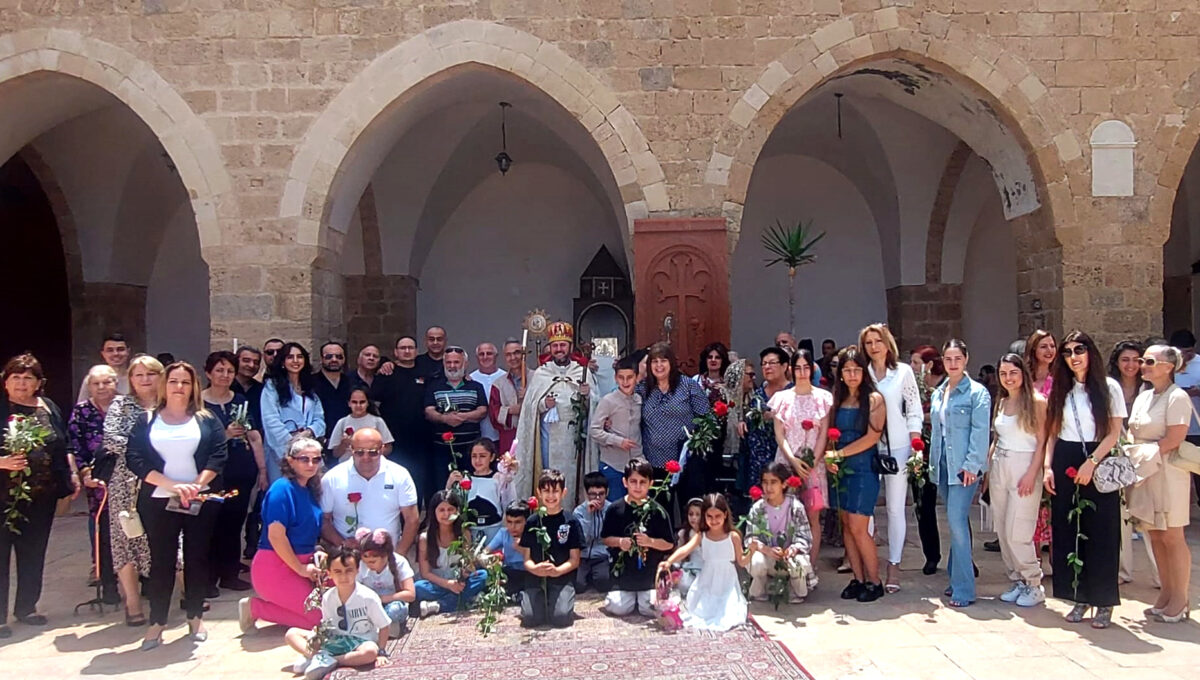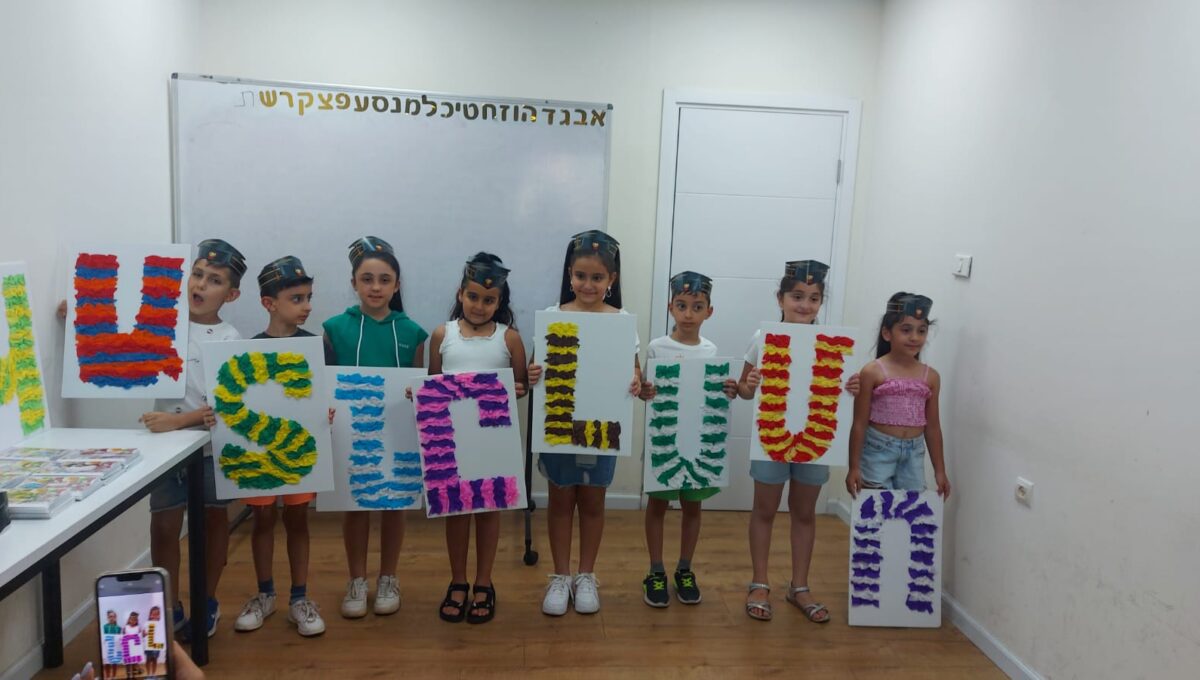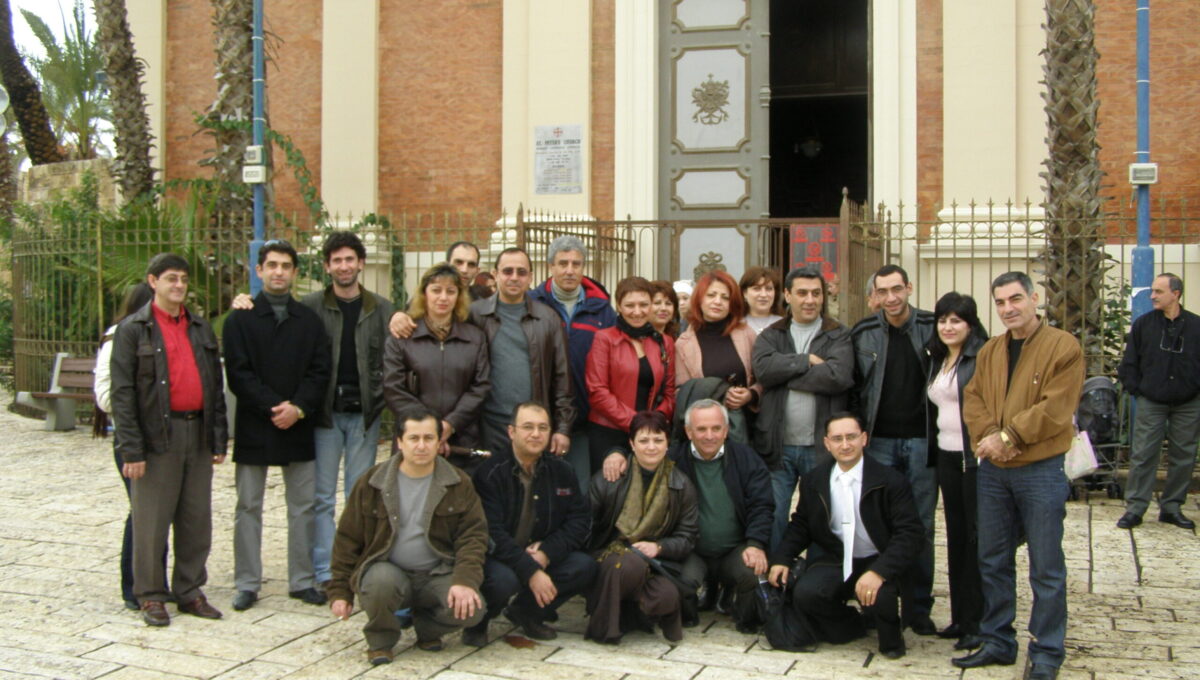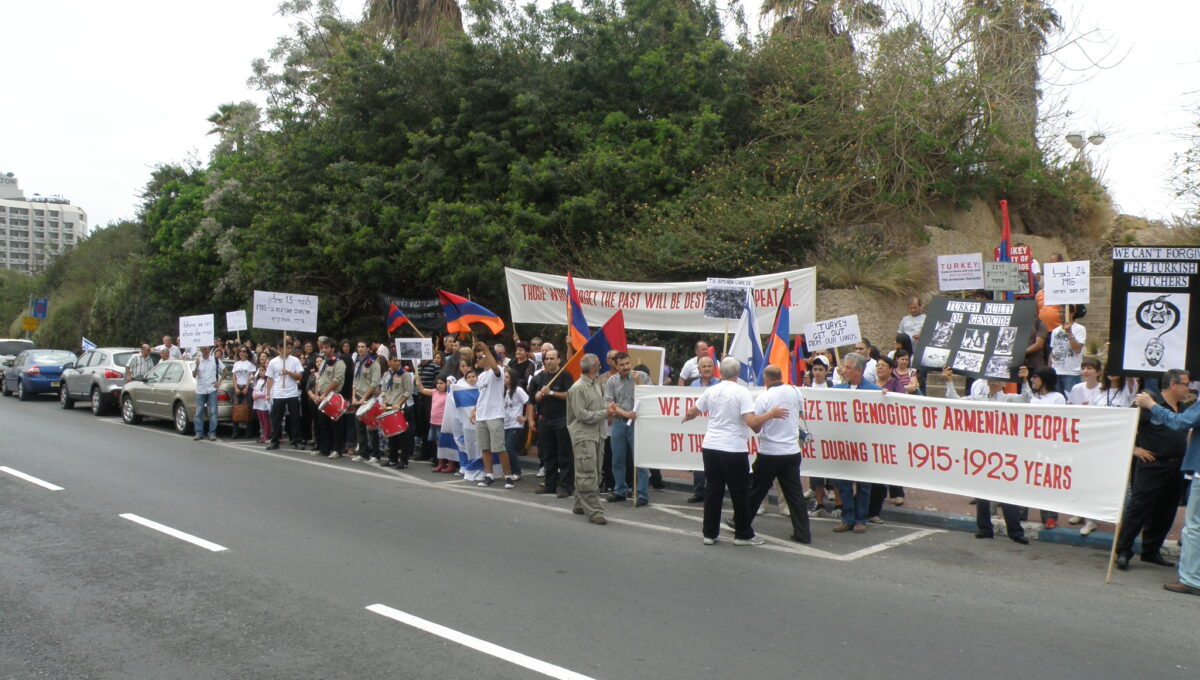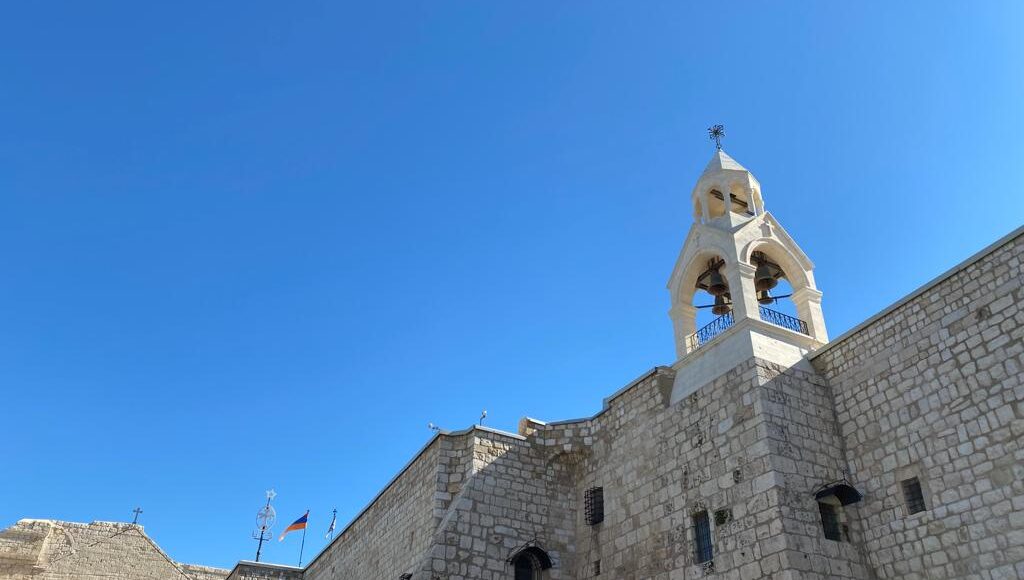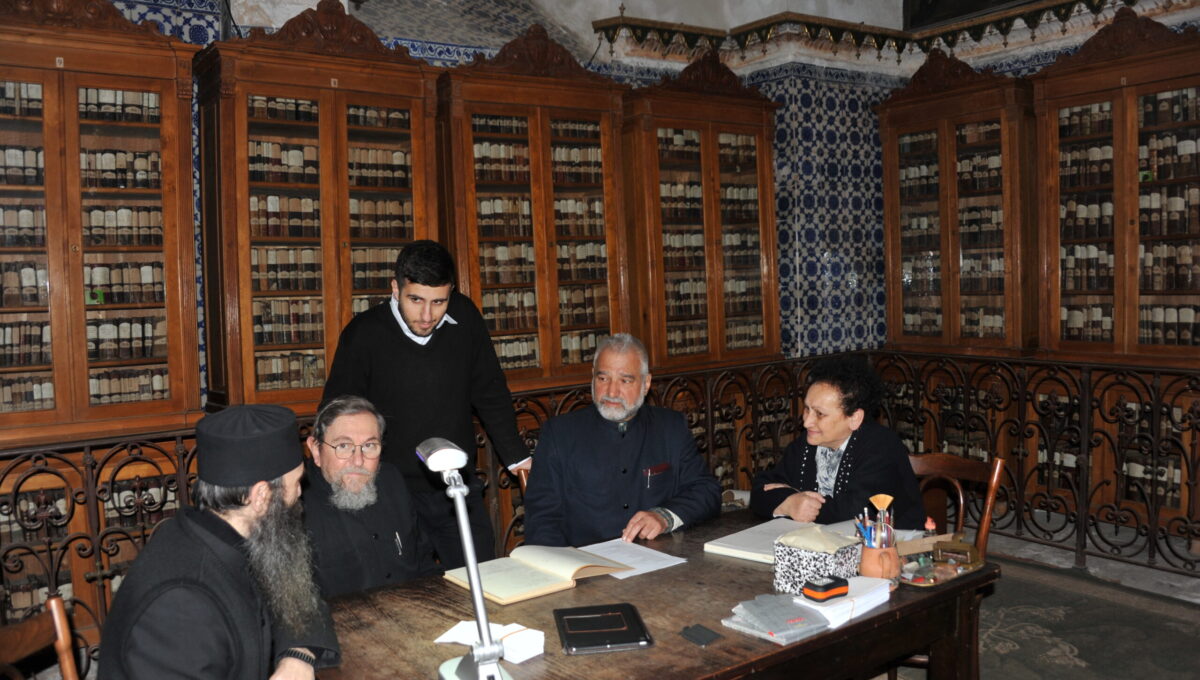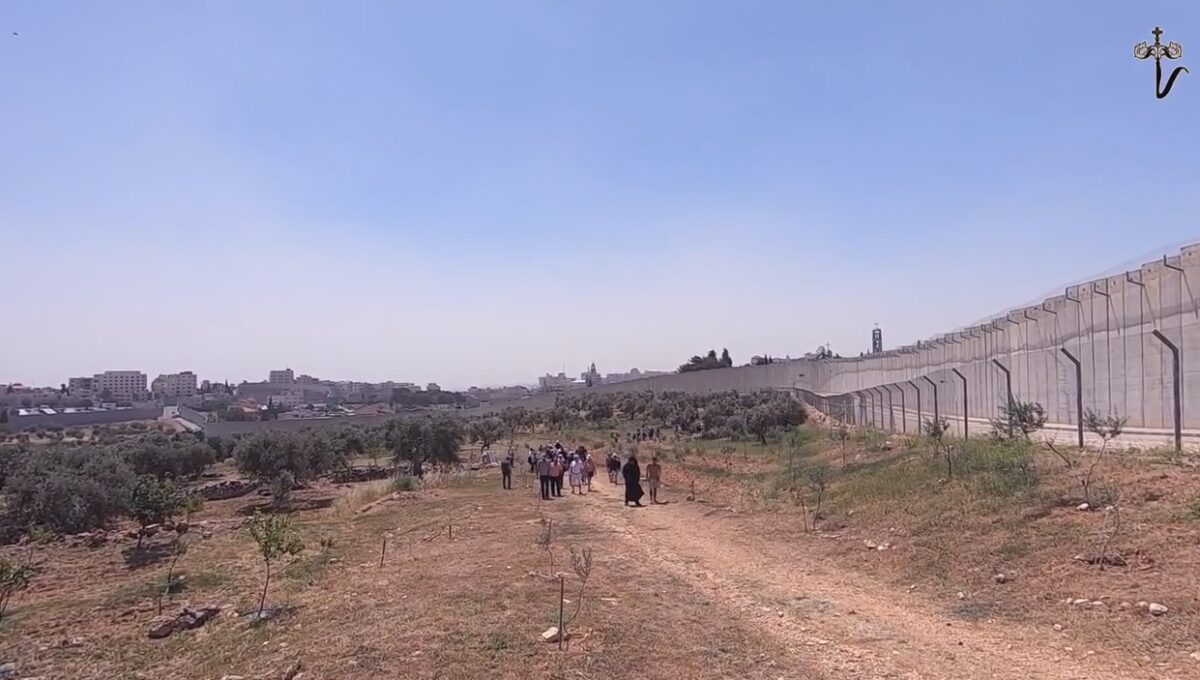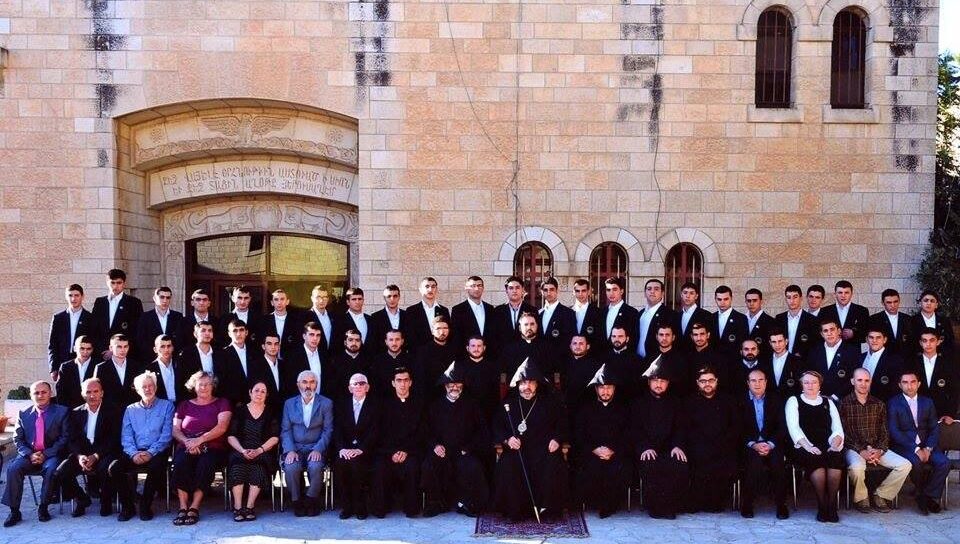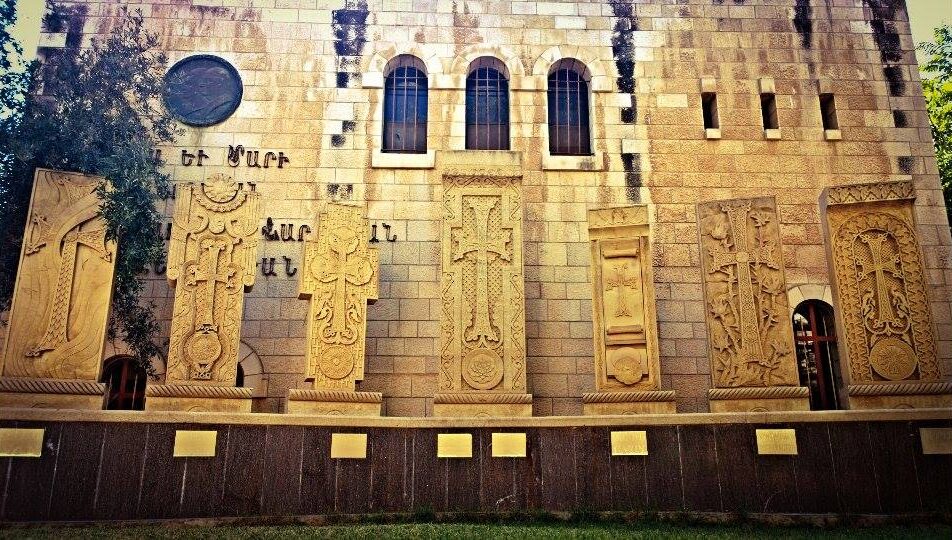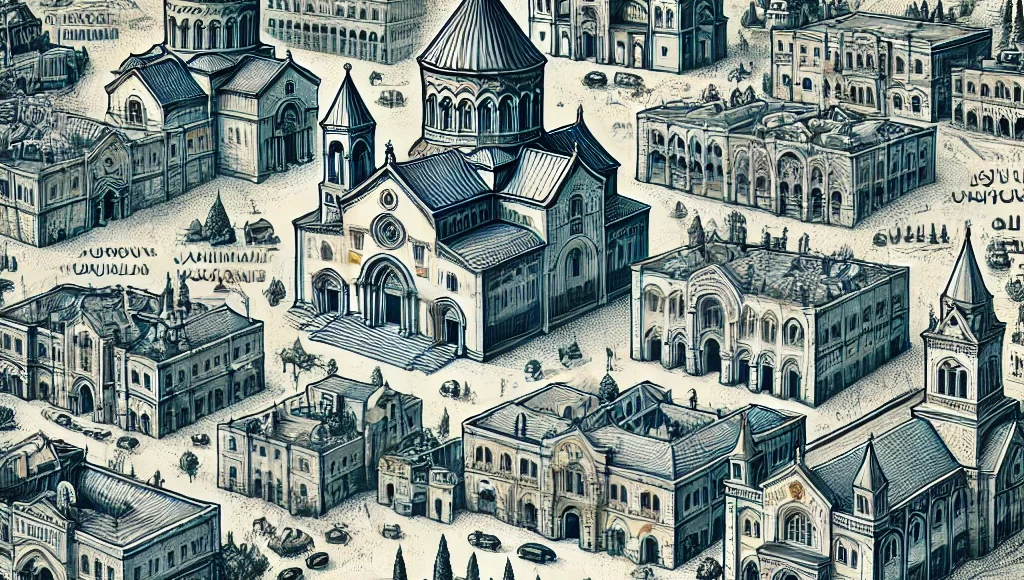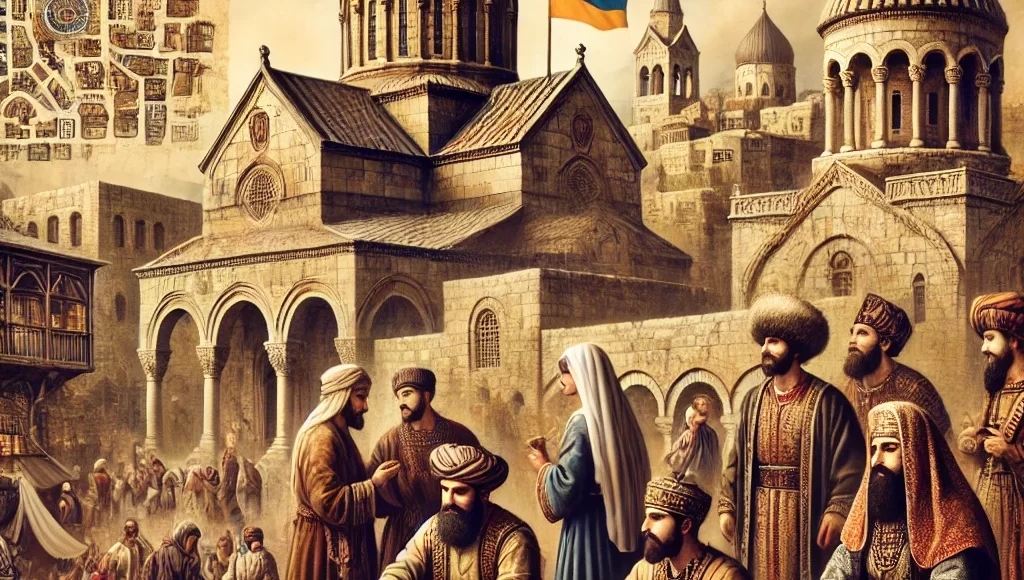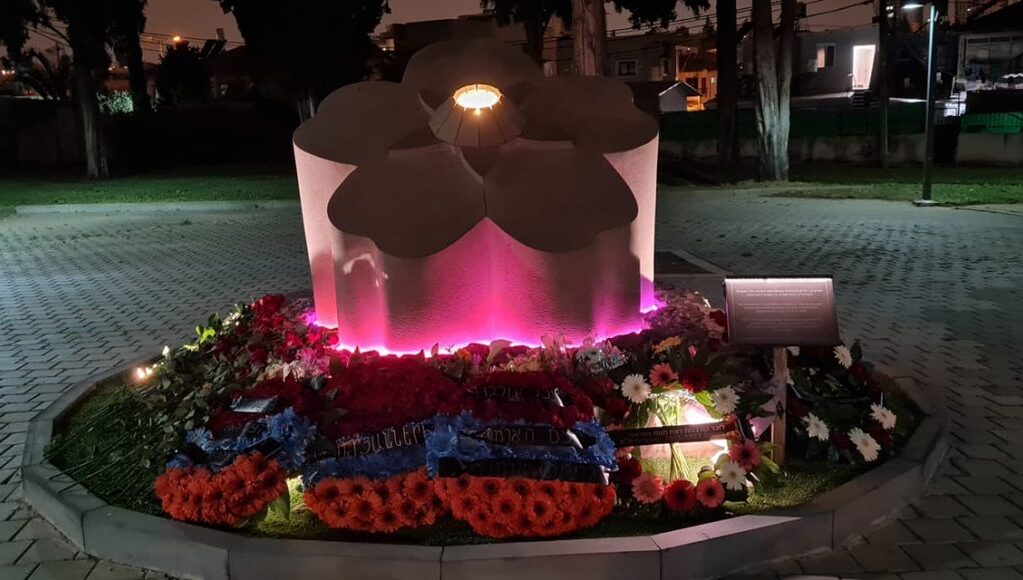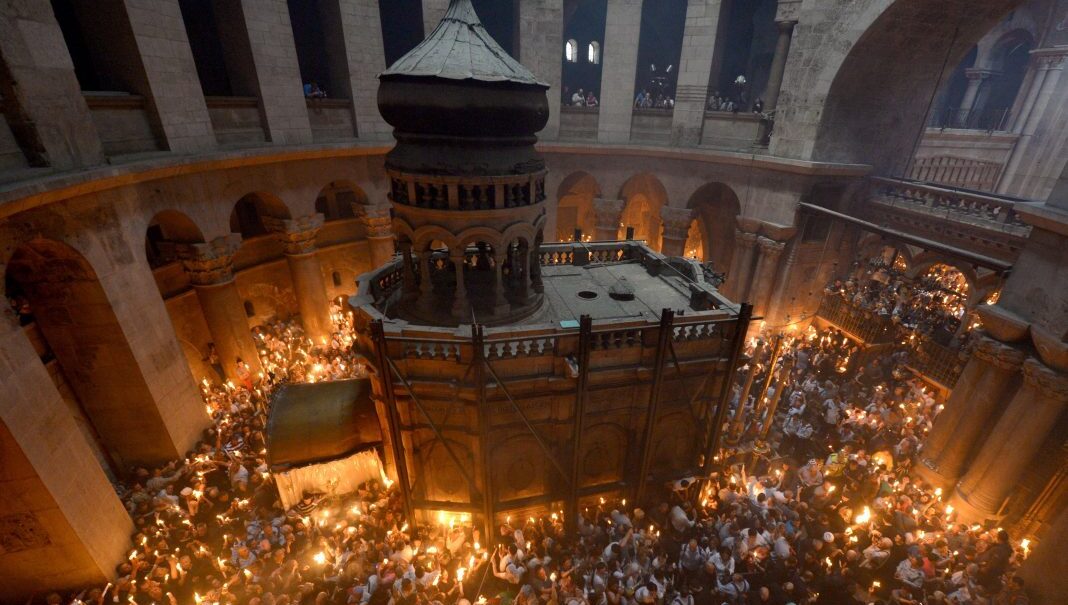The historic connection between the Armenian people and the Holy Land goes back to the days of Assyria and Babylon before the advent of Christianity. Even before the time of Armenian Kings, 3000 B.C from territory of Republic of Armenia has found many facts of trade relationship between Armenia and Mesopotamia And Armenian merchants had good friendship with Jewish merchants. At one time, Armenia and Palestine were part of the same empire. According to recorded history, the Armenian King Tigran II (95 to 55 B.C.), The Great “King of Kings,” conquered most of the northern part of the Fertile Crescent including Syria and for a short time, extended his political influence over Israel which at the time was ruled by the Jewish Hasmonean kings. Armenian-Jewish relations date back to the time of Armenian emperor Tigran the Great, who, retreating from Judaea, took 10,000 Jews with him on his return to the Kingdom of Armenia. Jews had helped to Great “King of Kings,” to build his new capital Tigranakert.
The Armenian presence in the Holy Land dates back to the earliest years of Christianity, even before the conversion of Armenian King Tirdat the Third on or about 301 A.D. There is recorded historical evidence that as early as 254 A.D. bishops of the Armenian Church, in cooperation with bishops of the Greek Orthodox Churches in Jerusalem and Alexandria, Egypt, were actively engaged in the discovery and confirmation of Holy Places deemed to be related to the activities of Jesus Christ, and the construction of edifices for the preservation of these early Christian treasures.
Further, from the inception of Christianity, Armenian pilgrims began trekking to the Holy Land on spiritual journeys in steady and continuous numbers, braving disruptive political upheavals and other hardships. A large number of them chose to remain in Jerusalem, and to take up residence in the proximity of the sanctuaries owned by the Patriarchate (the Armenian Convent), with the St. James Cathedral as its centerpiece. Eventually, these areas near the Patriarchate, located in the southwestern corner of the Old City of Jerusalem, constituted the Armenian Quarter, which today takes up one-sixth of the geographic area within the walls of the Old City. The pilgrims also built houses, churches, and convents in other areas, some no longer standing, like the one at the Musrara Quarter, a stone’s throw from the 15th Century walls of the Old City where, in 1991, archaeologists uncovered an incomparable mosaic, laid down by an unknown Armenian priest, Eustadius, in the 7th century. At its peak, the Armenian presence in Jerusalem numbered 25,000.
According to historical records, as early as the 3rd century A.D., the Armenian Church, under the uninterrupted leadership of successive bishops, not only maintained the integrity of the Holy Places, but also had a leading role in their protection and reconstruction following their repeated destruction by invading armies.
From the 4th through the 8th century A.D., monasticism took strong root in the Christian world, from the mountains of Asia Minor through the Holy Land, the Sinai Peninsula and the deserts of Egypt. Considered to be an honorable profession in the service of God, it attracted scholars, educators and artisans of all kinds. With the influx of thousands of monks and pilgrims from Armenian cities, Armenian monasteries were established in the Holy Land, particularly in the hills outside Jerusalem, near the Dead Sea, and the Sinai Desert in the south. The monks became an influential creative force and pioneered the enrichment of the Church with an invaluable trove of manuscripts and archives. The development of the Armenian Lectionary, consisting of a comprehensive anthology of Armenian church readings, hymns and celebration of feasts, liturgical calendar, and numerous saints’ days, was a unique accomplishment. These elements and others have become an integral part of the tradition of the Armenian Church in the Holy Land thus making the Armenian Patriarchate a very unique institution throughout the world.
Because of the Armenian Church’s enhanced prestige, the leading bishop of the Church was elevated to the status of Patriarch sometime in the 5th century A.D. The first formally recorded Patriarch of Jerusalem was named Abraham who, in the middle of the 7th Century A.D., received a charter and official recognition from the Arab Caliph Omar Ibn-Il-Khattab of the Omayyad (Damascus) Dynasty. The charter enumerated the rights and privileges of the Armenian Church in the Holy Land, guaranteeing its integrity and security.
On the back wall facing the main entrance to the St. James Convent there is an elaborately carved inscription in Arabic which, loosely translated, warns all intruders: `This decree from our Lord Sultan and King Al-Daher Abu Sayid Mohammed, cursed be to all those and their sons through generations, and may Almighty God curse whoever harms or inflicts any injustice to this Holy Place. Abu Kheyer Razan hereby guarantees this to the St. James Armenian Convent in Jerusalem. In the year of Mohammed 854 (1488 A.D.)’. This and previous protective edicts have helped strengthen and perpetuate the integrity of the Patriarchate and have provided a basis for succeeding conquerors to honor these pledges.
The final and most important pledge was made by the written declaration of the Turkish Sultan, Abdul Majid, in 1852. This declaration officially established the principle of “Status Quo” (i.e. existing “as is” condition) in the Holy Places, which defines, regulates and maintains, without change, the proprietary rights in the Holy Places granted exclusively to the three major Christian rites–Greek, Armenian and Latin Catholic–thus making the Armenian Church equal in stature to the Catholic and Greek Orthodox Churches despite its relatively small size.
As a result of the “Status Quo”, one interesting aspect unique to the Holy Places is the cadre of guards, caretakers, called “Kawasses” who were primarily Moslem, a choice seemingly inspired by logic. Not being Christian, they could impartially administer any Holy Place, thus eliminating points of contention between the three major Christian rites. Over the centuries, these functions were passed from father to son throughout succeeding generations. The Kawasses protecting the Armenian Patriarch have become such familiar figures over the past hundreds of years that the successive generations have learned Armenian and speak it fluently.
Throughout the ensuing decades the resident Armenian community continued to grow and prosper, yielding tradesmen and merchants who shared their prosperity with their Church by donating land and assisting in the construction of new churches, commercial buildings and housing. The need for printed materials in the Armenian language resulted in the establishment of the first printing press in Jerusalem in 1833 within the walls of the St. James Convent. The first issue of “SION”, the official monthly publication of the Armenian Patriarchate was first distributed to the public in 1866. In 1841 the first Armenian Theological Seminary was founded just north of Jerusalem, in the town of Ramle, and in 1845 that Seminary was physically moved to a newly-built complex within the confines of the Convent.
As World War I ended, and Palestine was liberated from the Ottoman Turks by the British, there was a large influx of Armenian refugees who were welcomed by the Patriarchate and settled in available facilities. With the increased population in and around the Patriarchate, children’s education became a growing matter of concern. Fortunately, the Seminary afforded a ready-made system for the education of boys at the elementary level. This approach, by its nature, must have provided future candidates for the Seminary and subsequent ordination into the priesthood. However, without the inclusion of girls in the scheme, the endeavor was not deemed to be complete. Finally, in the 1860’s, a small building was erected adjacent to the Seminary, thus creating the first girls’ elementary school in Jerusalem. These schools continued to operate well into the early 1920’s.
In 1925, through the efforts of the newly-elected Patriarch Yeghishe Tourian, a staunch believer in education, a unified elementary school came into existence. Patriarch Tourian set about modernizing the curriculum of the Seminary and acquiring highly-qualified instructors from the cadre of talented teachers and educators who had come to Jerusalem as refugees. He envisioned the construction and establishment of an educational institution under one roof to accommodate the growing number of children in the community. In 1929, the unified elementary school officially opened its doors. By consolidating disparate locations, including the St. Gayane Girl’s School, this elementary school became the first co-educational institution in the Holy Land and was renamed School of the Holy Translators (“Serpots Tarkmantchats Varjaran”) after the Sts. Sahag and Mesrob, the inventors of the Armenian alphabet in approximately 400 A.D. It is in existence today.
These organs of the Armenian Patriarchate of Jerusalem–the School, the St. James Cathedral, the Patriarchate, the Armenian Seminary, the Galouste Gulbenkian Library, and the Edward and Helen Mardigian Museum – together with its custodianships of the Holy Places – form the core of the Armenian presence in Jerusalem today.
1921, the National Assembly was abolished and the Jerusalem Patriarchate re-asserted its independence in the conduct of its internal affairs. However, it continued to rely on the canonical and organizational guidelines of the 1881 and 1888 documents pertaining to the operation of the St. James Brotherhood with some modifications. Recent efforts in preparing a modern version of these documents have not come to fruition.
During Ottoman rule the election of the Patriarch of Jerusalem was subject to the final approval of the sultan. With the British in control, the process for government ratification fell on the shoulders of the British King and his cabinet. At first, they did not know how to handle this new responsibly. However in time, special procedures and protocols were promulgated through the Commissioner in Palestine, which lasted until May 14, 1948 when the responsibility fell to the King of Jordan who controlled the Old City until 1967.
From 1948, after the elections of Armenian Patriarch of Jerusalem by the principle of “Status Quo” all Armenian Patriarchs should be recognized by the leaders of 3 countries – Israel, Palestine and Kingdom of Jordan.
During the 1948 Arab/Israeli war some members of the community took refuge within the walls of the St. James Convent. Many others left the country for the safety of countries around the world (Soviet Armenia, the U.S., South America, Europe, Australia etc.).Thus some of the residences were forced to remain vacant becoming victims of vandalism. The greatest damage was inflicted on the entire Quarter during the 1967 war between Israel and the Kingdom of Jordan.
At the center of the incident, the entire district was bombed. The buildings where the priests lived, the students of the seminary were damaged as a result of the bombings on both sides, were completely evacuated. Most of the residential area was evacuated. Some areas were illegally appropriated by the Jews. The patriarchate is still trying to remove them, but to no avail. Some of them have long-term leases. The Armenian Patriarch of Jerusalem from March 22, 1990 to October 12, 2012 was Archbishop Torgom Manukyan, who was a very prominent figure in the Armenian reality of the time, an intellectual and philosopher. Archbishop Torgom Manoogian received a number of academic awards, including the title of Honorary Doctor of the General Theological Seminary in New York. In 1986, he received two major American awards. “Statue of Liberty” և “Elise Island” Medals of Honor.
Patriarch Torgom had a great contribution to the development of international ecumenical relations. He served on the Committee of the National Assembly of the Churches of Christ in the United States and chaired the Religion in American Life Council. He was also a member of the board of directors of the “Call of Conscience” foundation. Patriarch Torgom was the author of 20 monographs, including three collections of poetry, the Armenian S. Liturgy study, books dedicated to the Armenian Genocide մանրամասն Detailed guide to the holy places of Jerusalem. The patriarch was a well-known Komitas scholar. On January 24, 2013, after the death of Archbishop Torgom Manoogian, the Congregational Assembly of Jerusalem elected the 97th Patriarch, Archbishop Nourhan Manoogian, who held the post of Patriarch of Lusara. Without waiting for the recognition of all parties, especially Israel, according to the “Status Quo”, the Patriarch initiated his ordination, thus preventing the “practice of making concessions” in exchange for recognition by our community.
Through the efforts of Patriarch Nourhan Manukyan, in order to preserve the estates and to emphasize the presence of the Armenians in the Holy Land, pilgrimages to the “Mr. Ter” estate are organized annually. Great importance was attached to the planting of trees, international conferences and concerts dedicated to the 100th anniversary of the Armenian Genocide throughout 2015. There are many land issues that arose after the construction of the security wall by Israel and the patriarchate received compensation from the Israeli army for damages to the “Mr. Lord” estate. The Armenian Quarter is still on the map, but its future looks bleak. The fact that it is adjacent to the Jewish quarter in the east does not help much. It is adjacent to the Arab Quarter and during the clashes the Arab terrorists do not hesitate to penetrate the Armenian Quarter.
There is a fear that the Armenian quarter will thin out again in the coming years. The Armenians lost a lot of their own lands, in Israel and in Palestine. It was captured on both sides. Since the Israeli-Palestinian wars and terrorist attacks, the situation in the Armenian Quarter has been deteriorating year by year. For example, in 1948, the Armenian population in Jerusalem was over 25,000. Currently, about 2,000 Armenians live in the Armenian Quarter.
The total number of Armenians in Israel, including the Armenians of the former Soviet republics, Armenia and the West Bank, is about 8,000. But the ancient Armenians, who are part of BC. Of the descendants of the first-century Armenians և Armenians who survived the Armenian Genocide (1915-22), there are about 2,500 people in Jerusalem, Jaffa, Ramle and Haifa. Most of them had Jordanian citizenship; only recently did they obtain Israeli citizenship, in many cases retaining Jordanian passports. There are branches of two traditional parties in Jerusalem, the ARF Dashnaktsutyun and the ADL, as well as the Benevolent Club. Separate information on the activities of parties and clubs will be posted on the website. The rest are families from the former Soviet republics. They live in central Israel, in the southern and northern parts of the country.
The first non-governmental organization was registered in Israel in 2004 under the name “Ararat” Union of Armenians of Israel. In 2005, the Israeli Ministry of Justice registered Petah Tikva, the Nairi Union of Israeli-Armenians, the only non-governmental organization operating in Israel today, whose main mission is not only the preservation of the Armenian identity, but also the Mother Strengthening ties with the homeland. This year marks the 14th anniversary of the union’s fruitful activity. At the invitation of the Ministry of Diaspora, the Union has been participating in the Armenia-Diaspora Pan-Armenian Forum of Journalists since 2014. The Nairi Union is part of the Joint Commission on the Armenian Genocide in Israel and has implemented a number of serious programs both within the commission and with the Ministry of Diaspora.
The most powerful and certainly the most valuable assistance to the Artsakh army after the four-day war was provided by the Armenian community of Israel, three of the four members of whose delegation were members of the Nairi Union. The delegation was led by the head and coordinator of the Jerusalem Joint Commission, Archbishop Koryun Baghdasaryan, Chancellor of the Patriarchate.
Founded in 2013 in Petah Tikva, the Noyan Tapan Armenian Educational and Cultural Center works in partnership with the Nairi Union, and Petah Tikva is the second city after Jerusalem whose municipality cannot fully imagine its cultural life without the participation of Armenians.
In recent years, Nairi Union has organized numerous donations –
As a result, firewood was purchased and distributed to 570 extremely poor people in Gyumri, with many children and living in small houses. By paying the gas and electricity bills of the family for the whole winter.
Petah Tikva unions have done a lot of fruitful and pro-Armenian work throughout their activities in the form of Armenian concerts, exhibitions, educational and scientific programs, and together with Hay Dat they are fighting for Israel’s recognition of the Armenian Genocide, but it was more fruitful in 2020. beginning of the year. A memorial to the innocent victims of the Armenian Genocide in Petah Tikva, the first monument built on Jewish soil, was finally put into operation in the conditions of the widespread Coronavirus epidemic and Lockdown. The works were carried out for about three years and in January the monument and benches made in Armenia were brought and placed in Petah Tikva. In August, the Embassy of the Republic of Armenia and Ambassador Extraordinary and Plenipotentiary Armen Smbatyan officially opened in Israel. Consul Ani Khlghatyan had dozens of meetings with the leaders of Armenian communities and various organizations.
2020, just like a hundred years ago, brought many bitter trials and evils to the Armenian people. On September 27, the war provoked by Azerbaijan and Turkey, Armenia and Artsakh were defeated. Throughout the war, the entire Israeli community staged various rallies, large-scale rallies and other protests three times a week in front of Jewish state, executive and legislative buildings, private media outlets, demanding an end to arms supplies to Azerbaijan and presenting them to the Israeli public. information that Israel is actually arming terrorist groups. In addition to the protests that ended in early November, donations are still being made and the community of several thousand people, together with the Armenian Patriarchate of Jerusalem, has provided more than $ 300,000 in assistance to the dead, wounded, and most needy families affected by the war. There is not a single Armenian family that has not sent money to Armenia or Artsakh except for pan-Armenian or community donations.
The most important question for Armenian two thousand presence in Holly Land – is the status of Jerusalem and disport of Holy City. Under which country will be an Armenian quarter – that’s an important question for Armenian nation……..
